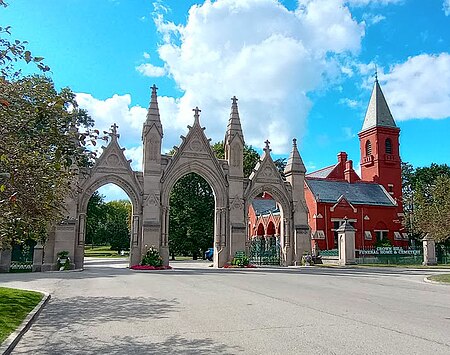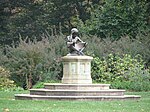Crown Hill Cemetery

Crown Hill Cemetery is a historic rural cemetery located at 700 West 38th Street in Indianapolis, Marion County, Indiana. The privately owned cemetery was established in 1863 at Strawberry Hill, whose summit was renamed "The Crown", a high point overlooking Indianapolis. It is approximately 2.8 miles (4.5 km) northwest of the city's center. Crown Hill was dedicated on June 1, 1864, and encompasses 555 acres (225 ha), making it the third largest non-governmental cemetery in the United States. Its grounds are based on the landscape designs of Pittsburgh landscape architect and cemetery superintendent John Chislett Sr and Prussian horticulturalist Adolph Strauch. In 1866, the U.S. government authorized a U.S. National Cemetery for Indianapolis. The 1.4-acre (0.57 ha) Crown Hill National Cemetery is located in Sections 9 and 10. Crown Hill contains 25 miles (40 km) of paved road, over 150 species of trees and plants, over 225,000 graves, and services roughly 1,500 burials per year. Crown Hill is the final resting place for individuals from all walks of life, from political and civic leaders to ordinary citizens, infamous criminals, and unknowns. Benjamin Harrison, 23rd president of the United States, and Vice Presidents Charles W. Fairbanks, Thomas A. Hendricks, and Thomas R. Marshall are buried at Crown Hill. Infamous bank robber and "Public Enemy #1" John Dillinger is another internee. The gravesite of Hoosier poet James Whitcomb Riley overlooks the city from "The Crown". Many of the cemetery's mausoleums, monuments, memorials, and structures were designed by architects, landscape designers, and sculptors such as Diedrich A. Bohlen, George Kessler, Rudolf Schwarz, Adolph Scherrer, and the architectural firms of D. A. Bolen and Son and Vonnegut and Bohn, among others. Works by contemporary sculptors include David L. Rodgers, Michael B. Wilson, and Eric Nordgulen. The cemetery's administrative offices, mortuary, and crematorium are located at 38th Street and Clarendon Road on the cemetery's north grounds. Crown Hill's Waiting Station, built in 1885 at its east entrance on 34th Street and Boulevard Place, serves as a meeting place for tours and programs. The Crown Hill Heritage Foundation, a nonprofit corporation established in 1984, raises funds to preserve the cemetery's historic buildings and grounds. Crown Hill Cemetery was listed on the National Register of Historic Places on February 28, 1973.
Excerpt from the Wikipedia article Crown Hill Cemetery (License: CC BY-SA 3.0, Authors, Images).Crown Hill Cemetery
West 38th Street, Indianapolis
Geographical coordinates (GPS) Address External links Nearby Places Show on map
Geographical coordinates (GPS)
| Latitude | Longitude |
|---|---|
| N 39.820277777778 ° | E -86.170555555556 ° |
Address
Crown Hill Cemetery
West 38th Street
46254 Indianapolis
Indiana, United States
Open on Google Maps







